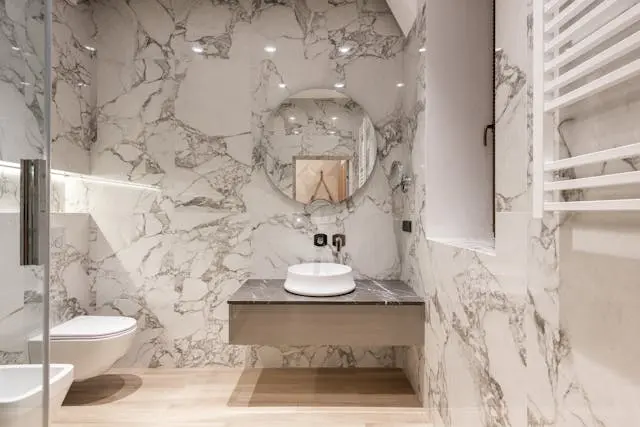Home decor tiles are one of the most versatile and stylish options for enhancing any room in your house. Whether you’re renovating your kitchen, updating your bathroom, or giving your living room a new look, the right tiles can completely transform the space. With so many materials, designs, and finishes available, choosing the perfect home decor tile might seem overwhelming. This guide aims to simplify that process by providing comprehensive information on the types of tiles, how to select the right one for your space and tips on installation and maintenance.
Understanding the Different Types of Home Decor Tiles
Home decor tiles come in various types, each offering distinct advantages depending on where and how they are used.
- Ceramic Tiles: Ceramic tiles are widely popular due to their affordability, durability, and variety of designs. They are perfect for areas with moderate foot traffic, such as kitchens and bathrooms.
- Porcelain Tiles: Porcelain tiles are denser, more water-resistant, and more durable than ceramic tiles. They are ideal for high-traffic areas and spaces exposed to moisture, like bathrooms and outdoor areas.
- Glass Tiles: These tiles add a sleek, modern touch to any room. Often used in backsplashes and accent walls, glass tiles are available in a wide range of colors and finishes, reflecting light beautifully.
- Stone Tiles: Natural stone tiles, including marble, granite, and slate, bring an earthy, luxurious feel to a space. They are best suited for areas where elegance and durability are key, such as entryways and living rooms.
- Metal Tiles: Offering a contemporary industrial look, metal tiles are commonly used in kitchens and bathrooms. They add a distinctive edge to modern and minimalist interiors.
How to Choose the Right Tile for Each Room

Selecting the right tile involves considering the room’s function, aesthetic goals, and practical needs.
- Bathroom Tiles: In bathrooms, moisture resistance is crucial. Porcelain or ceramic tiles with a matte finish are slip-resistant and durable, making them an excellent choice.
- Kitchen Tiles: For kitchens, durability and ease of cleaning are important. Consider ceramic or porcelain tiles for floors and glass or ceramic tiles for backsplashes.
- Living Room Tiles: Stone tiles or large-format porcelain tiles can create a sophisticated look in living rooms. Choose a style that complements the overall decor.
- Outdoor Tiles: For patios and outdoor areas, choose frost-resistant tiles like porcelain or natural stone. Ensure they have a textured surface for slip resistance.
Design Trends in Home Decor Tiles for 2024
Keeping up with the latest trends can help you make a stylish choice.
- Geometric Patterns: Tiles with geometric patterns are in vogue, adding visual interest to floors and walls.
- Large-Format Tiles: Large tiles with fewer grout lines create a seamless, spacious look, perfect for modern interiors.
- Earth Tones: Neutral shades like beige, gray, and earthy browns are trending, offering a versatile backdrop for any decor.
- Textured Tiles: Textured tiles add depth and dimension to spaces, making them popular for feature walls and backsplashes.
- Eco-Friendly Options: Sustainability is a growing concern, and eco-friendly tiles made from recycled materials are increasingly popular.
Installation Tips for a Flawless Finish
Proper installation is key to achieving a professional look.
- Surface Preparation: Ensure the surface is clean, dry, and level before installation. Any unevenness can lead to tile cracking or poor adhesion.
- Layout Planning: Plan the layout before starting, considering focal points and symmetry. This helps avoid awkward cuts and ensures a balanced design.
- Adhesive Application: Use the correct adhesive for your tile type and apply it evenly. Avoid applying too much adhesive, as it can cause the tiles to shift.
- Grouting: Once the tiles are set, apply grout to fill the spaces between them. Choose a grout color that complements the tiles.
- Sealing: For natural stone tiles, apply a sealant to protect them from stains and moisture. Regular resealing may be required depending on the stone type.
Maintaining Your Home Decor Tiles
Proper maintenance ensures the longevity and beauty of your tiles.
- Regular Cleaning: Sweep and mop your tiles regularly to prevent dirt buildup. Use a cleaner that is safe for your specific tile type.
- Grout Care: Grout can become stained over time. Clean it with a grout cleaner or a mixture of baking soda and water. Consider resealing the grout periodically.
- Preventing Damage: Avoid using harsh chemicals or abrasive tools on your tiles. For heavy furniture, use protective pads to avoid scratching the tile surface.
- Addressing Stains: Use a tile cleaner or a mixture of vinegar and water for stubborn stains. Test any cleaner on a small area first to ensure it does not damage the tile.
Creative Ways to Use Home Decor Tiles
Tiles aren’t just for floors and walls; they can be used creatively throughout your home.
- Accent Walls: Use decorative tiles to create a feature wall in your living room or bedroom. This adds texture and visual interest to the space.
- Fireplace Surrounds: Tiling the area around your fireplace can create a stunning focal point. Choose heat-resistant tiles for this purpose.
- Kitchen Islands: Use tiles to clad the sides of your kitchen island, adding a unique and stylish touch to your kitchen decor.
- Bathroom Niches: Add tiles to shower niches or recesses to make them stand out. This is both functional and decorative.
- Outdoor Steps: Tile the risers of outdoor steps to add color and pattern to your exterior spaces.
Budgeting for Your Tile Project

Understanding the costs involved can help you stay within budget.
- Material Costs: Tiles range in price depending on the material. Ceramic tiles are generally affordable, while natural stone and glass tiles can be more expensive.
- Installation Costs: Professional installation can be costly but ensures a flawless finish. DIY installation can save money but requires careful planning and skill.
- Additional Costs: Don’t forget to budget for grout, adhesive, and sealant, as well as any tools you might need for the installation.
- Contingency Budget: Always allow for a contingency in your budget to cover unexpected costs, such as additional materials or repairs.
Common Mistakes to Avoid When Choosing and Installing Tiles
Avoid these common pitfalls to ensure your tile project is successful.
- Choosing the Wrong Tile for the Space: Make sure the tile is appropriate for the room’s conditions, such as moisture or high traffic.
- Ignoring Tile Grading: Tile grades indicate durability. Choose a grade that matches the usage level of the area.
- Poor Surface Preparation: Skipping proper surface preparation can lead to uneven tiles and a poor finish.
- Incorrect Grouting: Inadequate grouting can lead to water damage and unsightly gaps.
- Underestimating Waste: Always buy extra tiles to account for breakage and future repairs.
Conclusion
Home decor tiles offer endless possibilities for enhancing the beauty and functionality of your home. By choosing the right type of tile, keeping up with the latest trends, and following best practices for installation and maintenance, you can create a stunning space that reflects your style. Whether you prefer a modern, rustic, or classic look, there’s a tile that can bring your vision to life. Start planning your tile project today and transform your home into the space you’ve always dreamed of.
FAQs
Q: What is the best type of tile for a high-traffic area?
A: Porcelain tiles are highly durable and water-resistant, making them ideal for high-traffic areas.
Q: How do I choose the right tile size?
A: Larger tiles can make a room appear bigger, while smaller tiles are great for intricate designs. Consider the room size and layout when choosing tile size.
Q: Can I install tiles over existing flooring?
A: Yes, but the existing floor must be level, clean, and stable. It’s also important to use the right adhesive for the job.
Q: How often should I reseal natural stone tiles?
A: Natural stone tiles should be resealed every 1-2 years to protect them from stains and moisture.
Q: Are eco-friendly tiles durable?
A: Yes, eco-friendly tiles made from recycled materials are designed to be both sustainable and durable.


